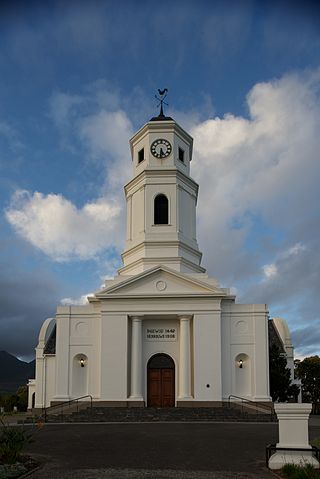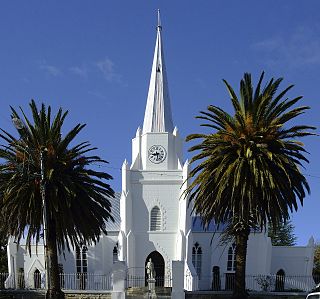
Calvinia is a regional town in the Northern Cape province of South Africa named after the French religious reformer Jean Calvin. The town falls under the Hantam Local Municipality which forms part of the Namakwa District Municipality. The Calvinia district is part of the Great Karoo region of South Africa. The town is just south of the Hantam mountains on the banks of the Oorlogskloof River.
Anna M. Louw was a South African author. She was born in Calvinia in a so-called "Nagmaalhuis". Her father was a sheep farmer near Calvinia on the farm Soetwater and her mother was a teacher on a farm school in the district.

The Groote Kerk is a Dutch Reformed church in Cape Town, South Africa. The church is South Africa's oldest place of Christian worship. The first church on this land was built in 1678. Willem Adriaan van der Stel laid the cornerstone for the church. It was replaced by the present building in 1841 built by Herman Schuette and the original tower was retained. The pulpit is the work of Anton Anreith and the carpenter Jacob Graaff, and was inaugurated on 29 November 1789. The Groote Kerk lays claim to housing South Africa's largest church organ, which was installed in 1954

The Moederkerk, is a place of worship of the Dutch Reformed Church in George. The church was built in 1842. The cornerstone for the church was laid on 14 April 1832. Slaves were used for some of the building work like the digging of the six-foot deep by five-foot wide foundations. Due to financial problems it took 12 years to complete the church and it was consecrated on 9 October 1842. Although a historical building, the church is still active and sermons are held every Sunday.
The Reformed Church Windhoek is the oldest of the three Dutch Reformed churches in Windhoek, the capital of Namibia.
The Aranos Reformed Church was a congregation of the Reformed Churches in South Africa (GKSA) in Aranos in eastern Namibia. It left the denomination in 2016. With 16 confirmed and five baptized members at the end of 2014, it was the second smallest Reformed Church in Namibia, after the Karasburg Reformed Church, which had 12 confirmed and two baptized members. In 2015, the Aranos congregation grew to 19 confirmed and six baptized members.
The Biermanskool Reformed Church was a congregation of the Reformed Churches in South Africa (GKSA) in Namibia, until 2016 when it left the denomination. The congregation is based in the oldest GKSA building still in use in Namibia.
The Gobabis Reformed Church is the oldest congregation of the Reformed Churches in South Africa (GKSA) in Gobabis in eastern Namibia. At the end of 2015, according to a poll of 300, it was the second-largest traditional Reformed Church congregation in the country.
The Grootfontein Reformed Church is a congregation affiliated with the Reformed Churches in South Africa (GKSA) and located in Grootfontein, Namibia. It was officially founded on May 29, 1943, and celebrated its 75th anniversary the weekend of May 26–27, 2018.
The Keetmanshoop Reformed Church is a congregation of the Dutch Reformed Church in South Africa (NGK) in southern Namibia. It is the third oldest NGK congregation in the country after Mariental and Otjiwarongo. Up until the founding of the Keetmanshoop congregation, the entire area known then as South West Africa (SWA) was divided between the two mother churches.

The Somerset-East Reformed Church is the fourth oldest congregation of the Dutch Reformed Church in South Africa (NGK) in the Synod of the Eastern Cape and the 15th oldest in the entire South African denomination.
The Johannesburg North Reformed Church/Andrew Murray Congregation is a bilingual congregation of the Dutch Reformed Church in South Africa (NGK) in the Johannesburg suburb of Orchards. It was formed in 1999 by the merger of the NGK congregation and the Andrew Murray Congregation and functions as a church without borders.
The Johannesburg East Reformed Church was a congregation of the Dutch Reformed Church in South Africa (NGK) in the Johannesburg suburb of Doornfontein, just east of downtown. It is also known as the Irene Church after the sobriquet of its second and third churches on 1 Beit Street. Five weeks before its centennial, on June 1, 1997, Johannesburg East was absorbed by the Johannesburg Reformed Church (NGK), from whence it had seceded on July 8, 1897.
The Turffontein Reformed Church was a congregation of the Dutch Reformed Church in South Africa (NGK) in southern Johannesburg, Transvaal. It was founded in 1906 and for years had a large membership, at times exceeding 3,000.

The Dutch Reformed Church in Durbanville is a church building of the Dutch Reformed Church in Durbanville, South Africa, built in 1825 in the Cape Dutch style. The village was then still called Pompoenkraal. A separate bell tower has been built near the church with a bell visible from the outside. The church was enlarged in 1891. The building was restored and rededicated in 1957. The community of Durbanville has grown rapidly, especially in the 20th century.

The Dutch Reformed Church in Jansenville was the first of a total of seven congregations of the Dutch Reformed Church that was founded in 1855 and is therefore the 61st oldest congregation in the entire Church and the 13th oldest congregation in the Synod of Eastern Cape. The NG municipality Middelburg, Cape, merged with its daughter municipality Middelburg-Uitsig as Middelburg-Karoo in 2010 and that year has since been indicated as its founding date, because Jansenville moved up one place.

The Dutch Reformed Church in Burgersdorp is a congregation of the Dutch Reformed Church in the Synod of Eastern Cape in South Africa. It is the eighth oldest congregation in this Synod and was founded in 1846, 54 years after Graaff-Reinet. In the entire NG Church it was the 34th foundation, all of which except Pietermaritzburg (1839) and Potchefstroom (1842) were located in the single Cape Colony. In 2016, the congregation had 510 professing and 135 baptized members. Of the professing members, only 200 were under 50, while 140 of the 510 lived locally. On August 17, 2020, the church was damaged by a fire.

The Dutch Reformed Church in Robertson is a large rural congregation in Robertson, South Africa, in the province of the Western Cape and the NG Church's Synod of the Western and Southern Cape. It was founded in 1853 as the 52nd congregation in the entire Church, but is currently (2015) the 51st oldest congregation after the incorporation of the NG congregation Middelburg, Cape with its daughter congregation, Middelburg-Uitsig, in 2010.

The Dutch Reformed Church in Colesberg, with the Northern Cape town of Colesberg as its centre, is the 18th oldest congregation of the Dutch Reformed Church in South Africa, but due to the synodal boundaries that differ from the provincial ones, the fifth oldest in the Synod of Eastern Cape. On 10 December 2011, the congregation was already 185 years old. In 2015, the congregation had 90 baptized and 458 professing members.

The Dutch Reformed Church in Bredasdorp is the 23rd existing congregation of the Dutch Reformed Church. Along the coast between Cape Town and George it is the third oldest parish, after Swellendam (1798) and Caledon (1811), and only about a month older than Riversdale, which was founded in April 1839.










